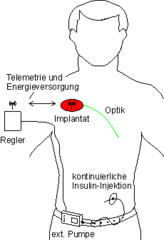In vivo Determination and Control of Blood-Sugar Levels
Contact persons
Project description
Every cell of the human body is supplied with nutrients, including glucose, which is the main energy source for the human metabolism. While an extremely low blood-sugar level can lead to unconsciousness, a steady elevated level can damage blood vessels and nerve cells. This pathophysiological state is known as "diabetes mellitus". The most common sequelae that can subsequently develop are blindness, coronary and peripheral circulatory disorders, stroke and chronic kidney failure.
The pancreas is responsible for the regulation of the blood- sugar in the body. In the diabetic state, this physiological control-loop is disturbed, typically caused by difficulties with insulin production or sensitivity. Today diabetes is more or less properly handled through blood-sugar measurements taken several times daily and injections of the appropriate amount of insulin. With current sensors, each blood-sugar measurement requires a withdrawal of blood from the capillaries. The associated unpleasantness for the patient has prevented a large increase in the number of measurements per day, which would be necessary to control rapidly fluctuating blood-sugar levels. Partly for this reason, a continuous blood-sugar sensor is still lacking. Non-invasive concepts have been investigated for decades and are still problematic due to poor accuracy or safety, or long delay and down times.
An alternative could be an invasive measurement performed by a long-term implant placed in a blood vessel. Unfortunately chemical procedures for that purpose have not demonstrated the necessary long-term stability.
Due to newly developed micro-spectrometers featuring no moving components, a spectroscopic near-infrared measurement seems like a possible method for invasive blood-sugar testing, as long as it is possible to keep the optical components free from protein accumulation. The implant could telemetrically transmit future measurements to a controller that operates an insulin pump.
Publications
- Leonhardt, S. ; Heller, T. ; Heise, M.: Neuronale Netze zur nichtinvasiven Blutzuckermessung. In: Beiträge zur Jahrestagung der Deutschen Gesellschaft für Biomedizinische Technik e.V., Dresden, 1998, S. 584




